TOYOTA PRIUS PLUG-IN HYBRID 2016 Owners Manual
Manufacturer: TOYOTA, Model Year: 2016, Model line: PRIUS PLUG-IN HYBRID, Model: TOYOTA PRIUS PLUG-IN HYBRID 2016Pages: 744, PDF Size: 84.41 MB
Page 101 of 744
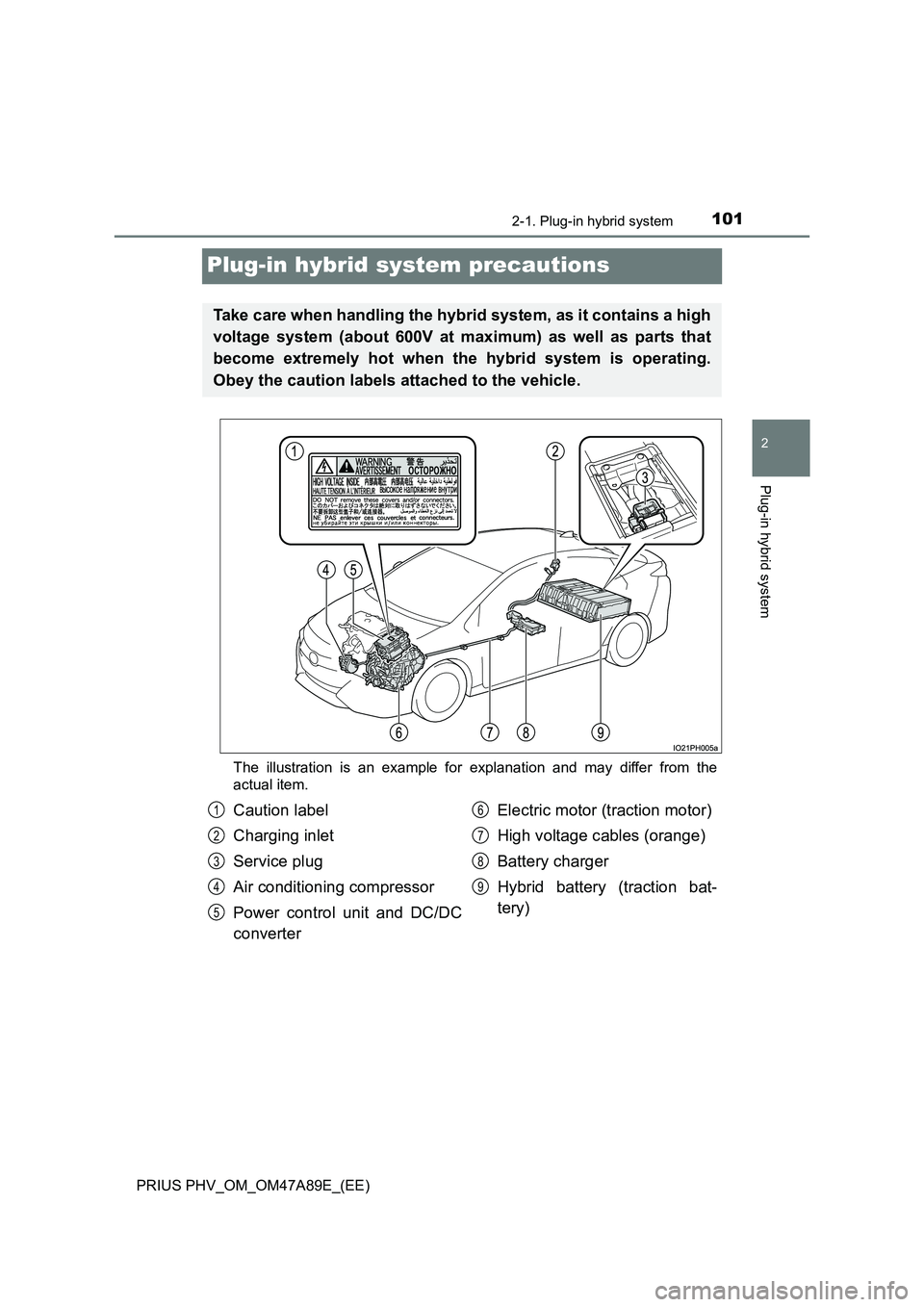
101
2
2-1. Plug-in hybrid system
Plug-in hybrid system
PRIUS PHV_OM_OM47A89E_(EE)
Plug-in hybrid system precautions
The illustration is an example for explanation and may differ from the
actual item.
Take care when handling the hybrid system, as it contains a high
voltage system (about 600V at maximum) as well as parts that
become extremely hot when the hybrid system is operating.
Obey the caution labels attached to the vehicle.
Caution label
Charging inlet
Service plug
Air conditioning compressor
Power control unit and DC/DC
converterElectric motor (traction motor)
High voltage cables (orange)
Battery charger
Hybrid battery (traction bat-
tery)1
2
3
4
5
6
7
8
9
Page 102 of 744
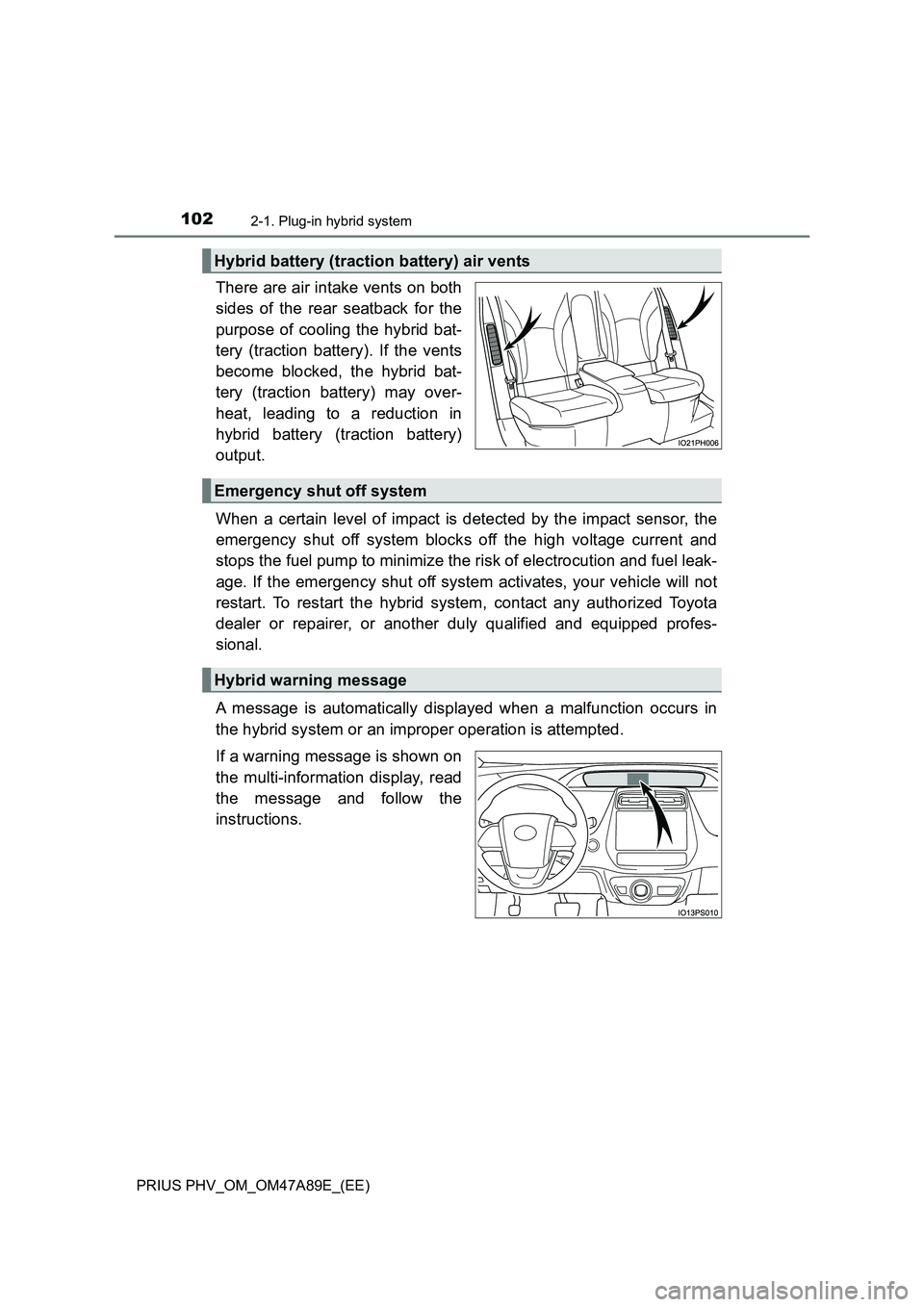
1022-1. Plug-in hybrid system
PRIUS PHV_OM_OM47A89E_(EE)
There are air intake vents on both
sides of the rear seatback for the
purpose of cooling the hybrid bat-
tery (traction battery). If the vents
become blocked, the hybrid bat-
tery (traction battery) may over-
heat, leading to a reduction in
hybrid battery (traction battery)
output.
When a certain level of impact is detected by the impact sensor, the
emergency shut off system blocks off the high voltage current and
stops the fuel pump to minimize the risk of electrocution and fuel leak-
age. If the emergency shut off system activates, your vehicle will not
restart. To restart the hybrid system, contact any authorized Toyota
dealer or repairer, or another duly qualified and equipped profes-
sional.
A message is automatically displayed when a malfunction occurs in
the hybrid system or an improper operation is attempted.
If a warning message is shown on
the multi-information display, read
the message and follow the
instructions.
Hybrid battery (traction battery) air vents
Emergency shut off system
Hybrid warning message
Page 103 of 744
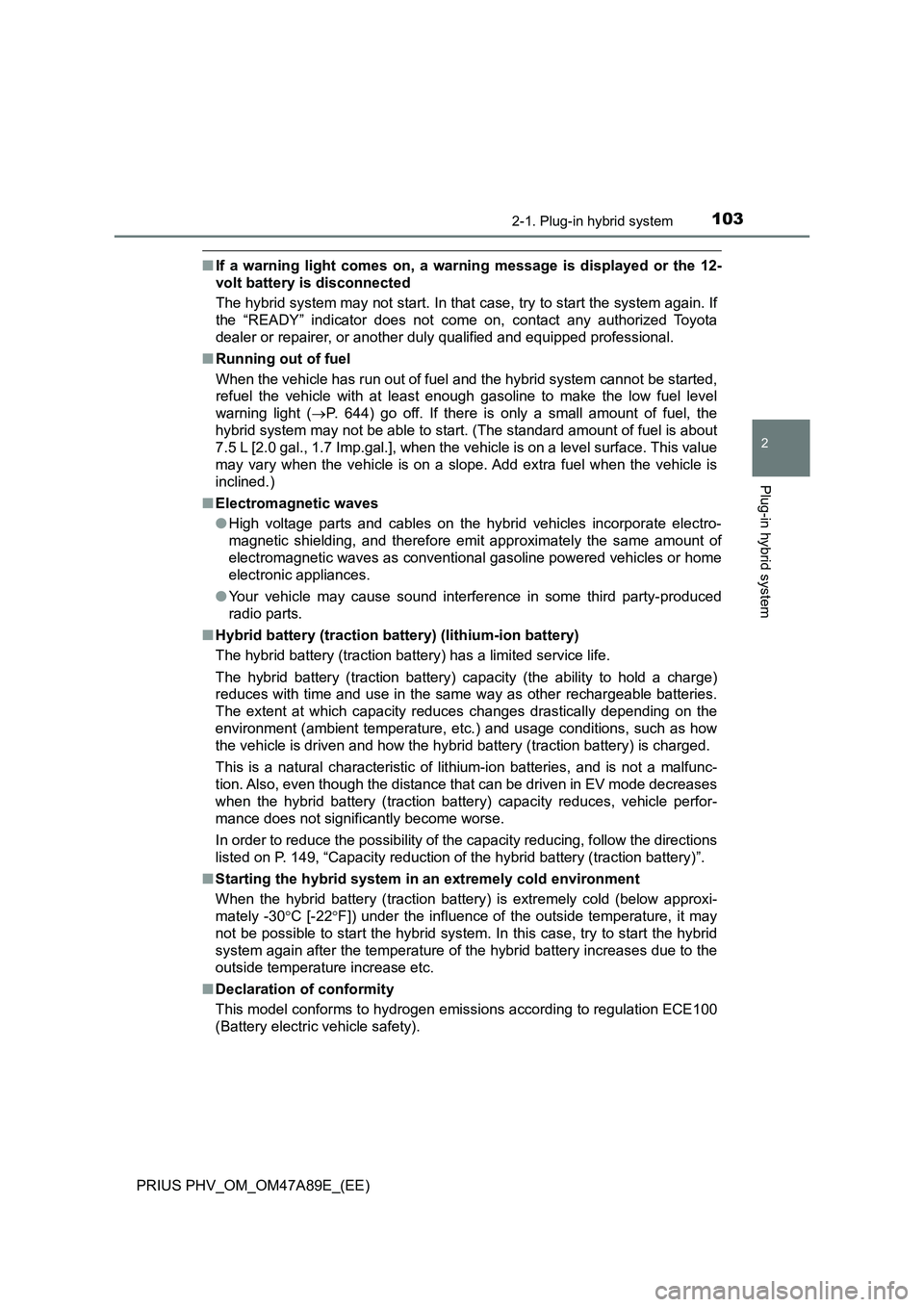
1032-1. Plug-in hybrid system
2
Plug-in hybrid system
PRIUS PHV_OM_OM47A89E_(EE)
■If a warning light comes on, a warning message is displayed or the 12-
volt battery is disconnected
The hybrid system may not start. In that case, try to start the system again. If
the “READY” indicator does not come on, contact any authorized Toyota
dealer or repairer, or another duly qualified and equipped professional.
■Running out of fuel
When the vehicle has run out of fuel and the hybrid system cannot be started,
refuel the vehicle with at least enough gasoline to make the low fuel level
warning light (P. 644) go off. If there is only a small amount of fuel, the
hybrid system may not be able to start. (The standard amount of fuel is about
7.5 L [2.0 gal., 1.7 Imp.gal.], when the vehicle is on a level surface. This value
may vary when the vehicle is on a slope. Add extra fuel when the vehicle is
inclined.)
■Electromagnetic waves
●High voltage parts and cables on the hybrid vehicles incorporate electro-
magnetic shielding, and therefore emit approximately the same amount of
electromagnetic waves as conventional gasoline powered vehicles or home
electronic appliances.
●Your vehicle may cause sound interference in some third party-produced
radio parts.
■Hybrid battery (traction battery) (lithium-ion battery)
The hybrid battery (traction battery) has a limited service life.
The hybrid battery (traction battery) capacity (the ability to hold a charge)
reduces with time and use in the same way as other rechargeable batteries.
The extent at which capacity reduces changes drastically depending on the
environment (ambient temperature, etc.) and usage conditions, such as how
the vehicle is driven and how the hybrid battery (traction battery) is charged.
This is a natural characteristic of lithium-ion batteries, and is not a malfunc-
tion. Also, even though the distance that can be driven in EV mode decreases
when the hybrid battery (traction battery) capacity reduces, vehicle perfor-
mance does not significantly become worse.
In order to reduce the possibility of the capacity reducing, follow the directions
listed on P. 149, “Capacity reduction of the hybrid battery (traction battery)”.
■Starting the hybrid system in an extremely cold environment
When the hybrid battery (traction battery) is extremely cold (below approxi-
mately -30C [-22F]) under the influence of the outside temperature, it may
not be possible to start the hybrid system. In this case, try to start the hybrid
system again after the temperature of the hybrid battery increases due to the
outside temperature increase etc.
■Declaration of conformity
This model conforms to hydrogen emissions according to regulation ECE100
(Battery electric vehicle safety).
Page 104 of 744
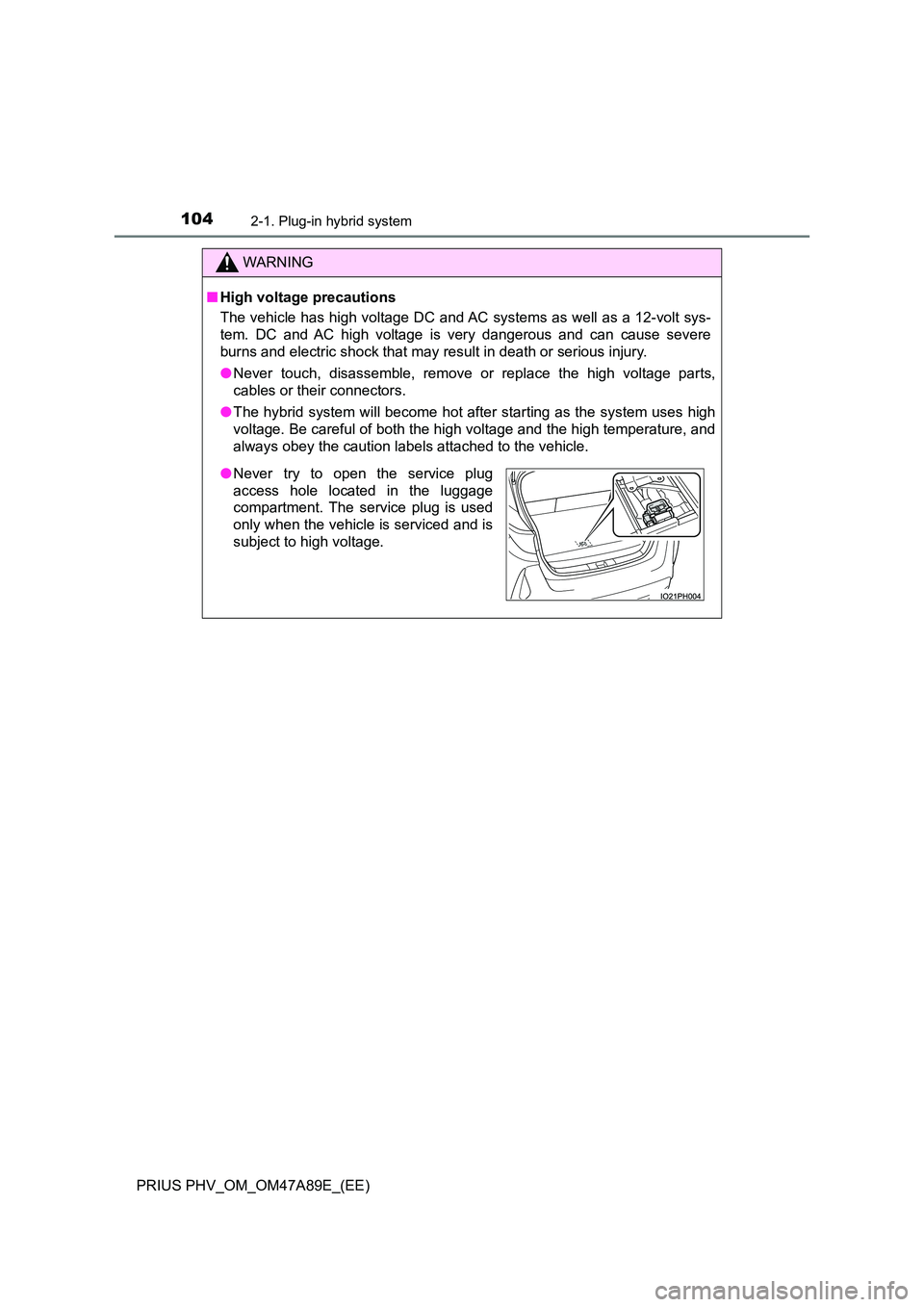
1042-1. Plug-in hybrid system
PRIUS PHV_OM_OM47A89E_(EE)
WARNING
■High voltage precautions
The vehicle has high voltage DC and AC systems as well as a 12-volt sys-
tem. DC and AC high voltage is very dangerous and can cause severe
burns and electric shock that may result in death or serious injury.
● Never touch, disassemble, remove or replace the high voltage parts,
cables or their connectors.
● The hybrid system will become hot after starting as the system uses high
voltage. Be careful of both the high voltage and the high temperature, and
always obey the caution labels attached to the vehicle.
● Never try to open the service plug
access hole located in the luggage
compartment. The service plug is used
only when the vehicle is serviced and is
subject to high voltage.
Page 105 of 744

1052-1. Plug-in hybrid system
2
Plug-in hybrid system
PRIUS PHV_OM_OM47A89E_(EE)
WARNING
■Road accident cautions
Observe the following precautions to reduce the risk of death or serious
injury:
● Pull your vehicle off the road, apply the parking brake, shift the shift posi-
tion to P, and turn the hybrid system off.
● Do not touch the high voltage parts, cables and connectors.
● If electric wires are exposed inside or outside your vehicle, an electric
shock may occur. Never touch exposed electric wires.
● Do not touch the battery if liquid is leaking from or adhering to it.
If electrolyte (carbonic-based organic el ectrolyte) from the hybrid battery
(traction battery) comes into contact with the eyes or skin, it could cause
blindness or skin wounds. In the unlikely event that it comes into contact
with the eyes or skin, wash it off immediately with a large amount of water,
and seek immediate medical attention.
● If electrolyte is leaking from the hybrid battery (traction battery), do not
approach the vehicle.
Even in the unlikely event that the hybrid battery (traction battery) is dam-
aged, the internal construction of the battery will prevent a large amount of
electrolyte from leaking out. However, any electrolyte that does leak out
will give off a vapor. This vapor is an irritant to skin and eyes and could
cause acute poisoning if inhaled.
● Do not bring burning or high-temperature items close to the electrolyte.
The electrolyte may ignite and cause a fire.
● If a fire occurs in the hybrid vehicle, leave the vehicle as soon as possible.
Never use a fire extinguisher that is not meant for electric fires. Using even
a small amount of water may be dangerous.
● If your vehicle needs to be towed, do so with front wheels raised. If the
wheels connected to the electric motor (traction motor) are on the ground
when towing, the motor may continue to generate electricity. This may
cause a fire. ( P. 634)
● Carefully inspect the ground under the vehicle. If you find that liquid has
leaked onto the ground, the fuel system may have been damaged. Leave
the vehicle as soon as possible.
Page 106 of 744
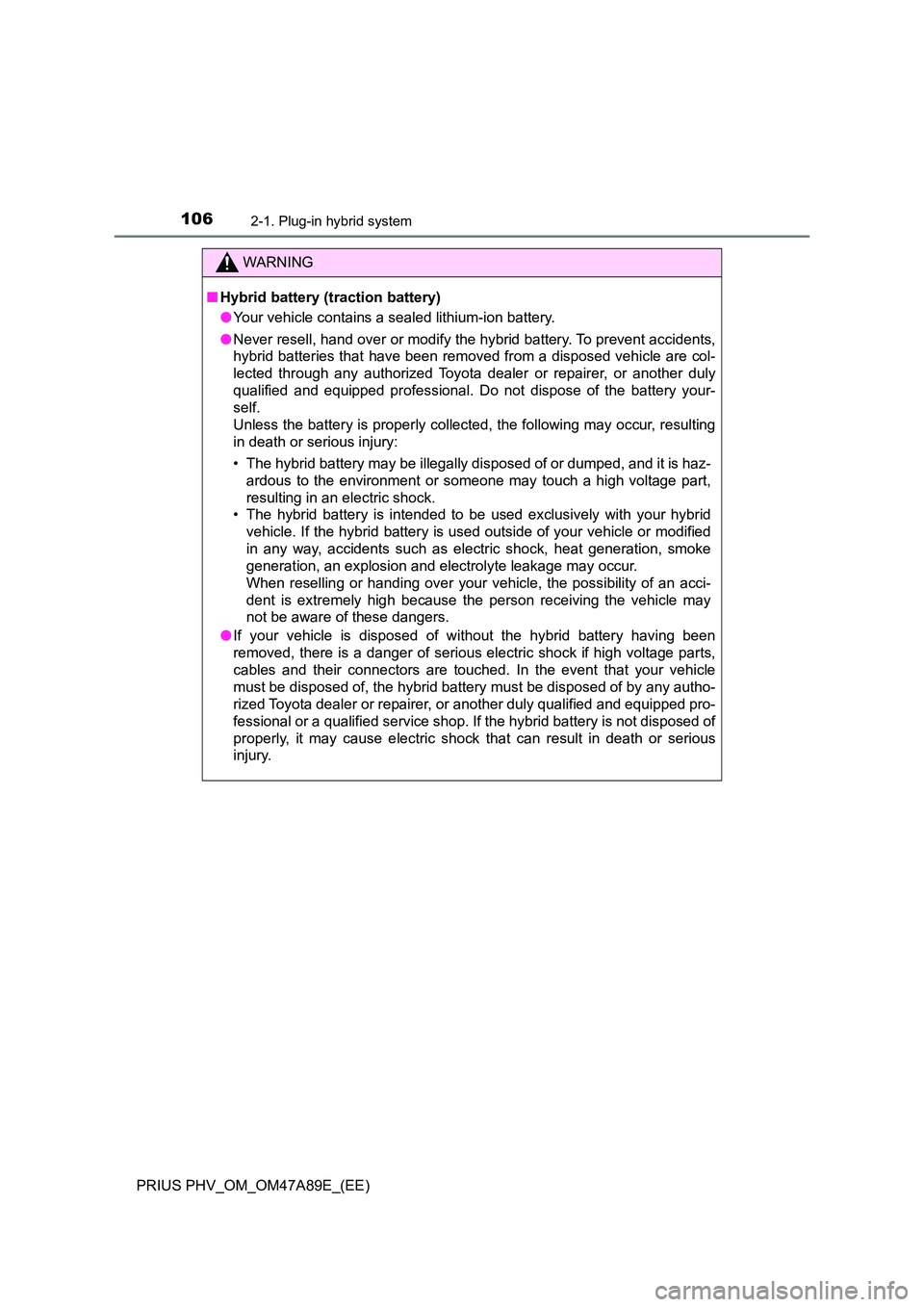
1062-1. Plug-in hybrid system
PRIUS PHV_OM_OM47A89E_(EE)
WARNING
■Hybrid battery (traction battery)
● Your vehicle contains a sealed lithium-ion battery.
● Never resell, hand over or modify the hybrid battery. To prevent accidents,
hybrid batteries that have been removed from a disposed vehicle are col-
lected through any authorized Toyota dealer or repairer, or another duly
qualified and equipped professional. Do not dispose of the battery your-
self.
Unless the battery is properly collect ed, the following may occur, resulting
in death or serious injury:
• The hybrid battery may be illegally disposed of or dumped, and it is haz-
ardous to the environment or someone may touch a high voltage part,
resulting in an electric shock.
• The hybrid battery is intended to be used exclusively with your hybrid
vehicle. If the hybrid battery is used outside of your vehicle or modified
in any way, accidents such as electric shock, heat generation, smoke
generation, an explosion and electrolyte leakage may occur.
When reselling or handing over your vehicle, the possibility of an acci-
dent is extremely high because the person receiving the vehicle may
not be aware of these dangers.
● If your vehicle is disposed of without the hybrid battery having been
removed, there is a danger of serious electric shock if high voltage parts,
cables and their connectors are touched. In the event that your vehicle
must be disposed of, the hybrid battery must be disposed of by any autho-
rized Toyota dealer or repairer, or another duly qualified and equipped pro-
fessional or a qualified service shop. If the hybrid battery is not disposed of
properly, it may cause electric shock that can result in death or serious
injury.
Page 107 of 744
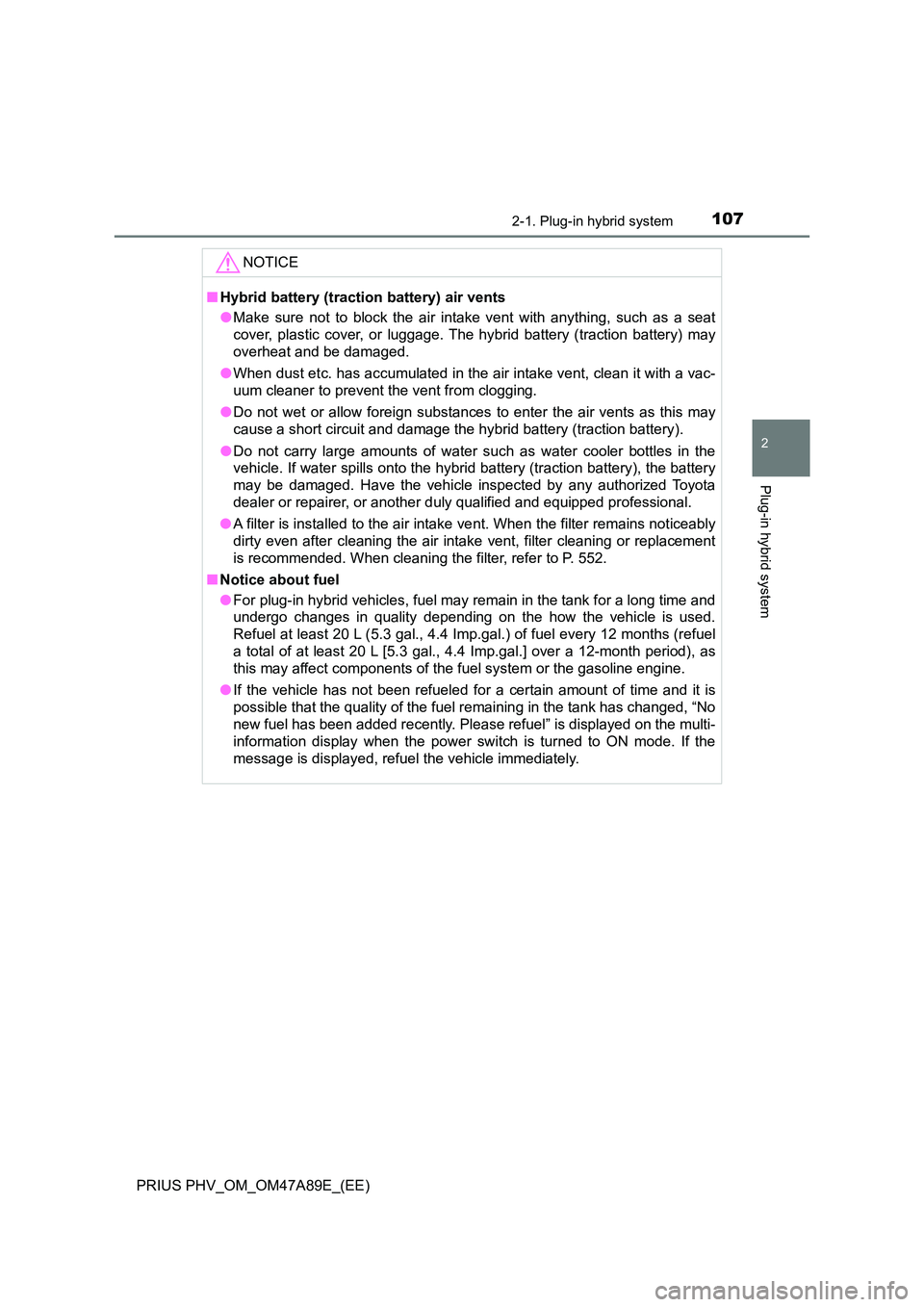
1072-1. Plug-in hybrid system
2
Plug-in hybrid system
PRIUS PHV_OM_OM47A89E_(EE)
NOTICE
■Hybrid battery (traction battery) air vents
● Make sure not to block the air intake vent with anything, such as a seat
cover, plastic cover, or luggage. The hybrid battery (traction battery) may
overheat and be damaged.
● When dust etc. has accumulated in the air intake vent, clean it with a vac-
uum cleaner to prevent the vent from clogging.
● Do not wet or allow foreign substances to enter the air vents as this may
cause a short circuit and damage the hybrid battery (traction battery).
● Do not carry large amounts of water such as water cooler bottles in the
vehicle. If water spills onto the hybrid battery (traction battery), the battery
may be damaged. Have the vehicle inspected by any authorized Toyota
dealer or repairer, or another duly qualified and equipped professional.
● A filter is installed to the air intake vent. When the filter remains noticeably
dirty even after cleaning the air intake vent, filter cleaning or replacement
is recommended. When cleaning the filter, refer to P. 552.
■ Notice about fuel
● For plug-in hybrid vehicles, fuel may remain in the tank for a long time and
undergo changes in quality depending on the how the vehicle is used.
Refuel at least 20 L (5.3 gal., 4.4 Imp.gal.) of fuel every 12 months (refuel
a total of at least 20 L [5.3 gal., 4.4 Imp.gal.] over a 12-month period), as
this may affect components of the fuel system or the gasoline engine.
● If the vehicle has not been refueled for a certain amount of time and it is
possible that the quality of the fuel remaining in the tank has changed, “No
new fuel has been added recently. Please refuel” is displayed on the multi-
information display when the power switch is turned to ON mode. If the
message is displayed, refuel the vehicle immediately.
Page 108 of 744
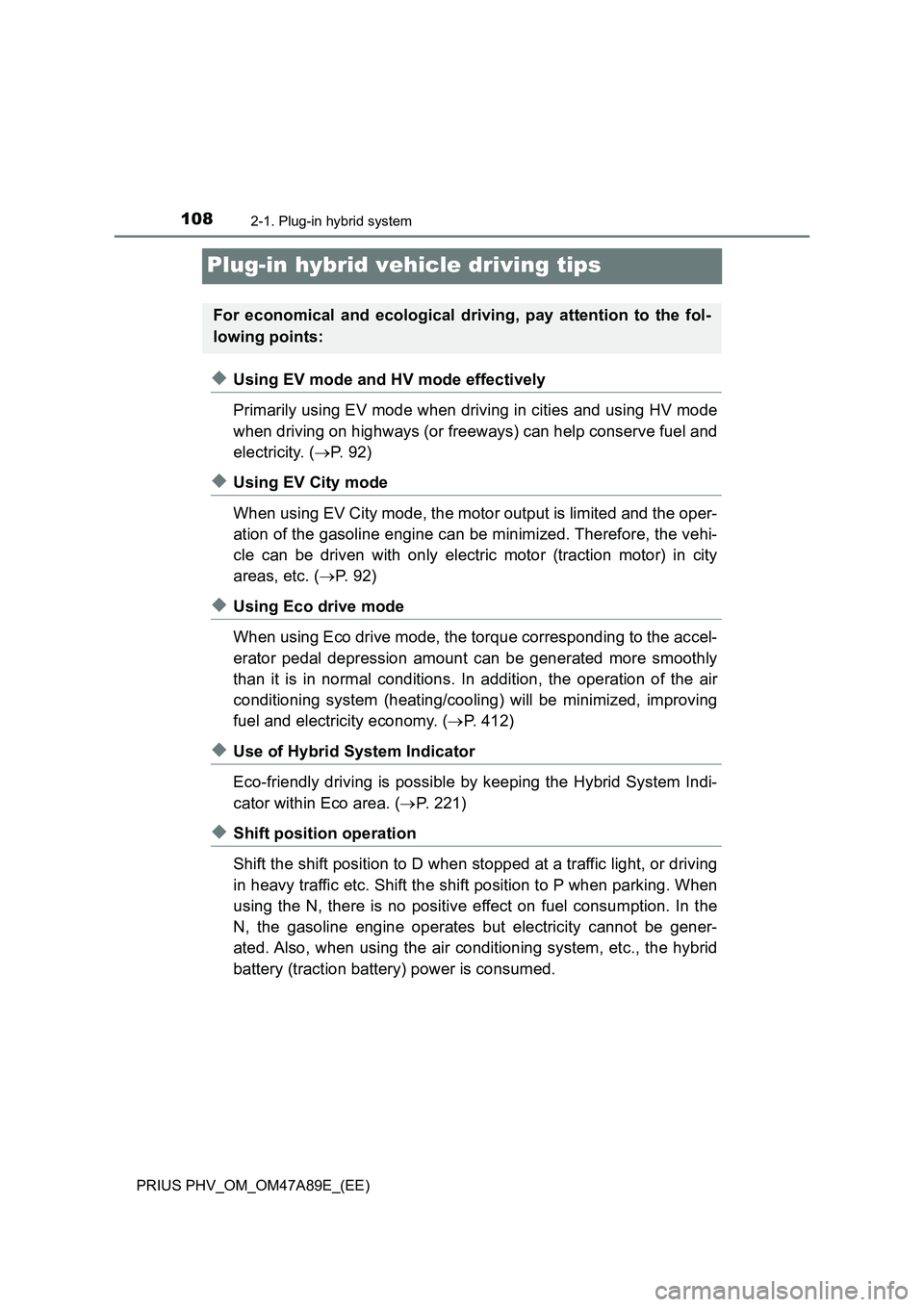
1082-1. Plug-in hybrid system
PRIUS PHV_OM_OM47A89E_(EE)
Plug-in hybrid vehicle driving tips
◆Using EV mode and HV mode effectively
Primarily using EV mode when driving in cities and using HV mode
when driving on highways (or freeways) can help conserve fuel and
electricity. (P. 92)
◆Using EV City mode
When using EV City mode, the motor output is limited and the oper-
ation of the gasoline engine can be minimized. Therefore, the vehi-
cle can be driven with only electric motor (traction motor) in city
areas, etc. (P. 92)
◆Using Eco drive mode
When using Eco drive mode, the torque corresponding to the accel-
erator pedal depression amount can be generated more smoothly
than it is in normal conditions. In addition, the operation of the air
conditioning system (heating/cooling) will be minimized, improving
fuel and electricity economy. (P. 412)
◆Use of Hybrid System Indicator
Eco-friendly driving is possible by keeping the Hybrid System Indi-
cator within Eco area. (P. 221)
◆Shift position operation
Shift the shift position to D when stopped at a traffic light, or driving
in heavy traffic etc. Shift the shift position to P when parking. When
using the N, there is no positive effect on fuel consumption. In the
N, the gasoline engine operates but electricity cannot be gener-
ated. Also, when using the air conditioning system, etc., the hybrid
battery (traction battery) power is consumed.
For economical and ecological driving, pay attention to the fol-
lowing points:
Page 109 of 744

1092-1. Plug-in hybrid system
2
Plug-in hybrid system
PRIUS PHV_OM_OM47A89E_(EE)
◆Accelerator pedal/brake pedal operation
●Drive your vehicle smoothly. Avoid abrupt acceleration and
deceleration. Gradual acceleration and deceleration will make
more effective use of the electric motor (traction motor) without
having to use gasoline engine power.
●Avoid repeated acceleration. Repeated acceleration consumes
hybrid battery (traction battery) power, resulting in poor fuel con-
sumption. Battery power can be restored by driving with the
accelerator pedal slightly released.
◆When braking
Make sure to operate the brakes gently and a timely manner. A
greater amount of electrical energy can be regenerated when slow-
ing down.
◆Delays
Repeated acceleration and deceleration, as well as long waits at
traffic lights, will lead to high fuel and electricity consumption.
Check traffic reports before leaving and avoid delays as much as
possible. When driving in a traffic jam, gently release the brake
pedal to allow the vehicle to move forward slightly while avoiding
overuse of the accelerator pedal. Doing so can help control exces-
sive electricity and fuel consumption.
◆Highway driving
●Control and maintain the vehicle at a constant speed. Before
stopping at a toll booth or similar, allow plenty of time to release
the accelerator and gently apply the brakes. A greater amount of
electrical energy can be regenerated when slowing down.
●Electricity consumption will increase significantly when driving at
high speeds in EV mode. If there will be a long distance to the
next external charging point after leaving a freeway, it is recom-
mended to drive in HV mode while on the freeway and change to
EV mode after leaving the freeway.
Page 110 of 744
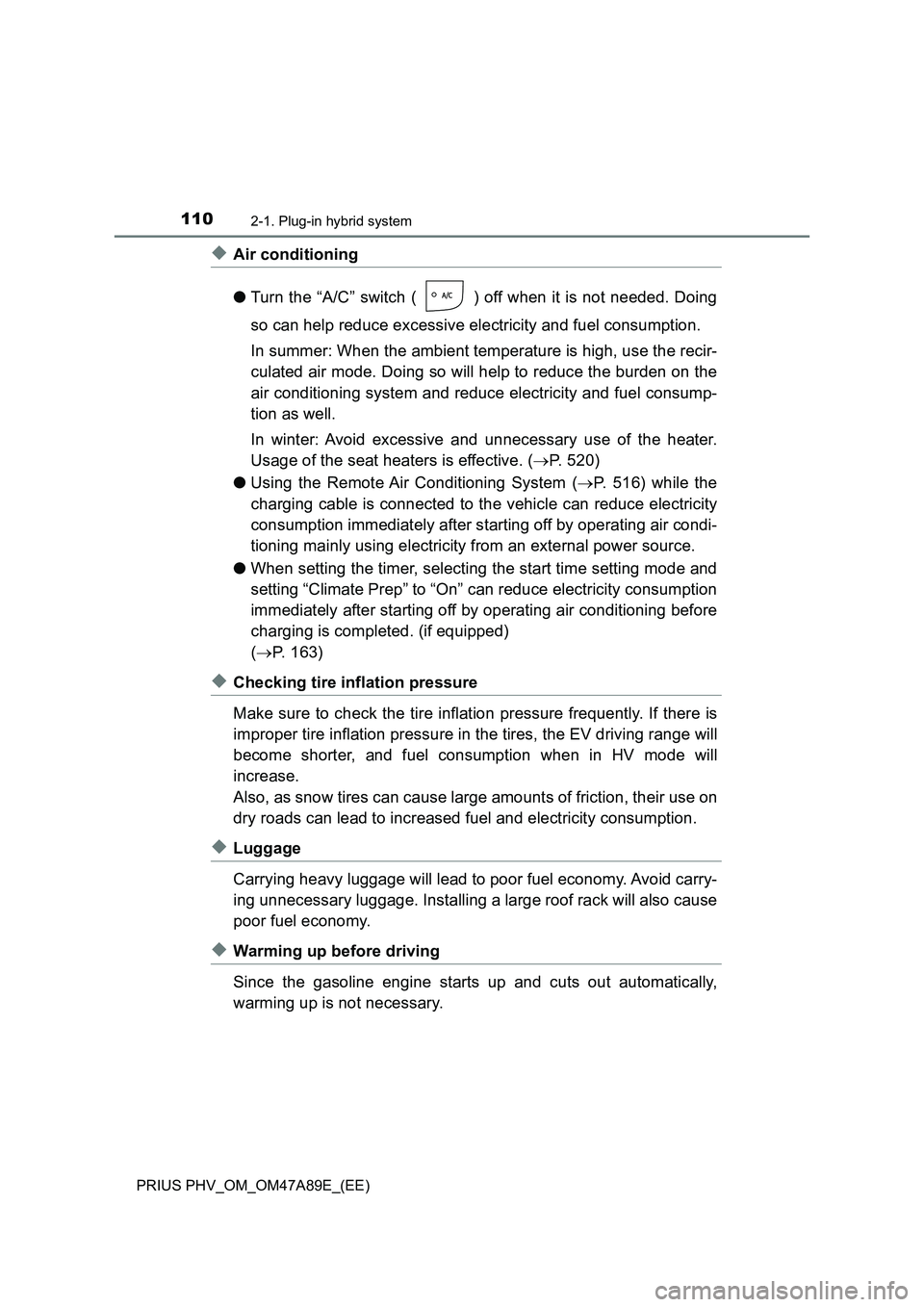
1102-1. Plug-in hybrid system
PRIUS PHV_OM_OM47A89E_(EE)
◆Air conditioning
●Turn the “A/C” switch ( ) off when it is not needed. Doing
so can help reduce excessive electricity and fuel consumption.
In summer: When the ambient temperature is high, use the recir-
culated air mode. Doing so will help to reduce the burden on the
air conditioning system and reduce electricity and fuel consump-
tion as well.
In winter: Avoid excessive and unnecessary use of the heater.
Usage of the seat heaters is effective. (P. 520)
●Using the Remote Air Conditioning System (P. 516) while the
charging cable is connected to the vehicle can reduce electricity
consumption immediately after starting off by operating air condi-
tioning mainly using electricity from an external power source.
●When setting the timer, selecting the start time setting mode and
setting “Climate Prep” to “On” can reduce electricity consumption
immediately after starting off by operating air conditioning before
charging is completed. (if equipped)
(P. 163)
◆Checking tire inflation pressure
Make sure to check the tire inflation pressure frequently. If there is
improper tire inflation pressure in the tires, the EV driving range will
become shorter, and fuel consumption when in HV mode will
increase.
Also, as snow tires can cause large amounts of friction, their use on
dry roads can lead to increased fuel and electricity consumption.
◆Luggage
Carrying heavy luggage will lead to poor fuel economy. Avoid carry-
ing unnecessary luggage. Installing a large roof rack will also cause
poor fuel economy.
◆Warming up before driving
Since the gasoline engine starts up and cuts out automatically,
warming up is not necessary.